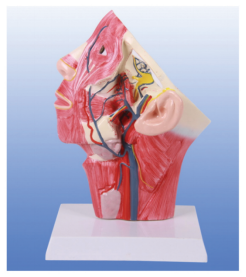16-01-2025
ADA MED SUPPLY LIMITED
Article tag: Head and facial vein model BIX-A1096 Medical anatomy model
Venipuncture is a fundamental and important technique in clinical practice, especially when faced with the operation of the head and facial veins. Due to the complex anatomy of the cephalic and facial veins and the high risk of puncture, healthcare professionals often face greater challenges when performing such procedures. In order to improve the success rate of puncture and reduce complications, can the cephalic and facial vein model, as a training tool, effectively improve the clinical judgment of medical personnel? This issue deserves further discussion.
Mechanisms to improve judgment

1. Simulate real clinical situations
The design of the cephalic and facial vein model is usually able to simulate the real anatomy of the human head and facial vein, and help the trainees to get in touch with the complex vein orientation and anatomical characteristics in training. Through repeated practice, students can gradually accumulate operational experience and improve the accuracy of clinical decision-making. When faced with real cases, participants are able to make faster and more accurate judgments based on the knowledge and skills gained during simulation training.
2. Improve anatomical awareness and touch
This model can simulate the elasticity and texture of veins, so that students can touch different types of veins during puncture training, and enhance the ability to judge the direction and depth of veins. In addition, the simulation model can help students identify the characteristics of different veins, such as the thickness of the blood vessel wall, the difficulty of puncture, etc., and provide a basis for judging the difficulty of puncture and selecting the appropriate needle and Angle in actual operation.
3. Cultivate emergency judgment ability
In clinical Settings, healthcare professionals are often required to make quick decisions under pressure. Through the simulation of the cephalic and facial vein model, students can train repeatedly in an environment without clinical risk, improving their emergency judgment ability in emergency situations. For example, when a simulated patient fails a venipentesis during emergency treatment, the trainee can quickly adjust the strategy according to the skills learned in training, improve the success rate and reduce complications.
Data support
According to a number of studies and training effect feedback, the use of venipentesis training model can significantly improve students' judgment and operational accuracy in actual operation. After using this model in some hospitals and medical training institutions, the data show that the success rate of trainees' puncture has increased by about 20%-30%, and the incidence of medical errors has decreased. In addition, after the model training, the students' emergency handling ability and judgment ability in actual operation have also been significantly improved, especially the reaction time and handling methods in complex situations have been qualitatively improved.
conclusion
There is no doubt that the cephalic and facial vein model can effectively improve the clinical judgment of medical staff. By simulating a real operating environment, providing specific tactile feedback and a variety of clinical situations, the model provides an ideal practice platform for participants to improve the accuracy and resilience of clinical operations without risk. With the continuous progress of simulation technology, this model will be more widely used in clinical teaching in the future, and become the core tool of medical staff skills training.